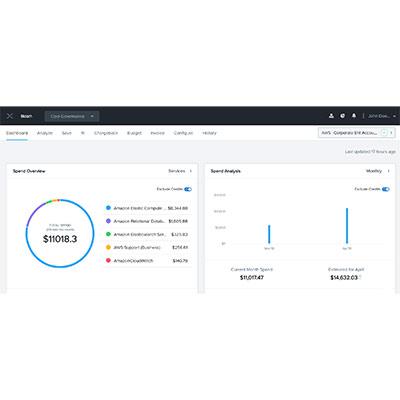CRN Exclusive: Nutanix CEO On The 'Big Bills' And 'Computing Sprawl' Of Public Cloud

Making The Case For Hybrid Cloud
Nutanix CEO Dheeraj Pandey says customers are realizing the high cost of public cloud, which is opening the door for channel partners to use Nutanix's cloud offerings to drive new revenue.
"Just like how there was a VM (virtual machine) sprawl with virtualization ten years ago, there's a lot of computing sprawl with public cloud, and it actually costs a lot of money because you're being billed by the hour, by the day, by the week. So a lot of customers are looking at that and saying, 'Can I get something on-premises that is very similar?'" said Pandey, in an interview with CRN. "And that's a great conversation starter for Nutanix."
Following the release of third quarter financial results in which the company beat Wall Street estimates for revenue but missed on earnings, Pandey talks to CRN about Nutanix's multi-cloud strategy, taking on public cloud and its channel charge in 2018.
What is your strategy for Nutanix's hybrid Xi Cloud Services and how that offering will compete with Amazon Web Services and Azure?
Our strategy is to build the best hybrid and multi-cloud infrastructure using software. AWS is pure-play public cloud. Microsoft is trying to do hybrid with Azure and Azure Stack, but Azure Stack is a very young product – it's like what Nutanix was in 2011, 2012. Then VMware is also trying out a hybrid [offering] with VMware on-prem and VMware on AWS – this is a really early journey to hybrid. Anybody who's done a really good job of the attention to detail of engineering and design will win this. It happened to hyper-convergence. Seven or eight years ago, there were a lot of hyper-converged companies. In the last five or three years, they've mostly wilted away because [the] infrastructure [market] is hard. When you just say that you have something that looks very similar and it doesn't work, like it happened with VMware vCloud Air, or HPE Helion or Cisco Intercloud – they just haven't worked through what it meant to build a cloud. … There's immense interest in Xi because we really built a cloud for the IT operator.

Do you see customers pulling back from public cloud because the economics of software-defined data center technology?
Yeah. It depends of the phase of the customer. If they have gone and done successful migration to the public cloud, what they're seeing is big bills which they have not accounted for in the past. Just like how there was a VM sprawl with virtualization 10 years ago, there's a lot of computing sprawl with public cloud, and it actually costs a lot of money because you're being billed by the hour, by the day, by the week. So a lot of customers are looking at that and saying, 'Can I get something on-premises that is very similar?' And that's a great conversation starter for Nutanix. Now there are other customers who have a lot of legacy infrastructure and they just have to try it out. So it depends on what phase of cloud adoption you're in, but there are a lot of customers thinking about, 'What does it mean to save [money]?' and saying, 'Well at least I can try it out before I know what's good and what's bad.'

What's one new product that Nutanix partners can win new cloud sales with?
The biggest one is Nutanix Beam and it makes the channel partners a true trusted advisor because they're going in and talking about cost and what it means to think about governance of cost and compliance, which is tied to security. They're saying, 'I'm not here to sell you any gear or boxes. Why don't you just use this SaaS appliance to put your AWS and Azure accounts in and see what exactly you can optimize?' It's a great conversation starter for anybody thinking about the cloud … Over time, we expect Beam to become the policy engine that will drive mobility of applications between on-premises and off-premises.

You just went on a hiring spree. How will this help channel partners?
One thing that I absolutely believe is that we have barely scratched the surface of the total addressable market (TAM) for this new architecture. By expanding the number of hardware platforms, the number of workload certifications and the number of geographies, we can tremendously grow the TAM not just of hyper-converged infrastructure, but hyper-converged clouds where we're talking about multi-cloud and app mobility across multiple clouds. In that vein, this hiring that we're doing is across the world, not just in the U.S. We are hiring a lot of sales people across the board as well as channel people to help support [partners].
Are there any tangible numbers you can give me about channel investment here?
We have hundreds of sales teams now so you can imagine that given the coverage that we have in 140 countries … a lot of that coverage is actually coming through partners.
You saidpartners have 'a lot of legacy to go displace.' Who are you looking to displace and where?
Fortunately, it's across the board. When they go talk about cloud, the first question partners should ask is, "Have you tried Nutanix Beam?' Especially if they're a cloud customer to begin with because that gives the cost governance and security compliance that will be a great conversation starter. Then they should look at how is it possible to orchestrate applications in multiple clouds – that's Nutanix Calm. Both Beam and Calm can be used in a multi-cloud world even if you don’t have any Nutanix infrastructure on-premises. The third thing partners should ask is, 'Before you go to the cloud, have you looked at what it means to own a cloud of your own?' Because of regulations, compliance, laws of the lands, and also because of the laws of physics – is it even possible for your users or your machine data to go to a large cloud data center?
What’s your channel partner call to arms for cloud?
The biggest one is, go get a foot in the door because that's what cloud consumption is all about. Get a foot in the door, start small with Nutanix and that same deployment will grow overtime. You can go after storage budget and compute budget and simplify your customers environment where there's no need for a fiber channel. You can sell them virtualization software and a lot of that stuff can come over time. The idea that you can start small is one of the best offers that they can provide to a customer who is thinking about cloud because cloud is all about starting small and paying as you grow. Nutanix has an immense opportunity for big business once you actually get a foot in the door.